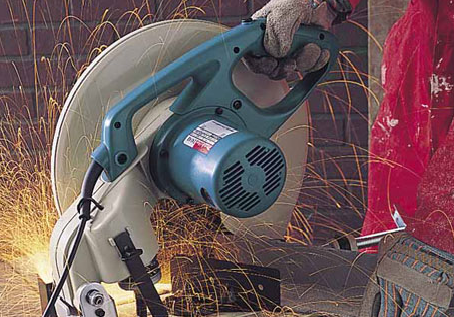There is a variety of grinders out in the market to choose from, offering a wide array of features, characteristics and prices. Often times, cost is a deciding factor when purchasing a grinder, but be cautious because cheap can be expensive in the long run. All factors should be considered when selecting a grinder. This article will present some fundamentals of selecting the best grinder size to save your shop money and time.
Basics of Right-Angle Grinders
Right-angle grinders can be found in a wide variety of diameter sizes ranging from 4 to 9 inches. These grinders all have a diameter-specific grinding wheel that must be mounted with the appropriate safety guard.
Two important facts about right-angle grinders that will reflect the efficiency in your process are output power and torque.
Most tool manufacturers will provide output and input power as two product descriptions. The amount of power a tool needs to operate is the input power. This doesn’t translate to a “better machine” factor. On the other hand, output power is the power used for tool operation after heat loss.
For example, two 6-inch right-angle grinders can have different characteristics. The first grinder can have an input power of 1700 W, output power of 1000 W and 59 percent efficiency. Considering only the “efficiency” factor, one would believe these two grinders are the same. However, the final power of the machine, the “true muscle,” is determined by looking at 1000 W compared to 800 W. That is a total of 200 W, or 22 percent power difference, between the two grinders.
Another point to consider when choosing a grinder is the interaction between torque and speed; more specifically, the speed at rated load. Because all grinders are submitted to a load when used, it makes sense to obtain a grinder that can maintain a high speed throughout its grinding operation. The first grinder has a lower speed under no-load operation, rated at 9600 rev/min, vs. the second grinder, which has 10,000 rev/min. However, when the grinder is submitted to a rated load, the first grinder is able to maintain its speed at 9600 rev/min and the second grinder drops to 7300 rev/min. That is a total of 30 percent speed loss.
So how much can a 200-W power difference affect grinding wheel performance? In recent benchmarks, improvement of 37 percent higher metal removal (work) and 10 percent higher grinding speed (productivity) have been seen. Both 6-inch grinding wheels stubbed out and the total work done on each wheel using each grinding was shown. The wheel mounted on the second grinder will have a total life of 20 minutes, a metal removal of 2.41 lb, and a speed of grind of 0.12 lb/min. In comparison, the first grinder will last an additional 5 minutes and remove a total of 3.30 lb with a speed of grind of 0.13 lb/min.
Note: In the process of evaluating these two 6-inch grinders, the technician burned out two of the second 6-inch grinders before all of the benchmarking could be completed. The second grinder is rated at 12 A and the average grinding current for these wheels was above 14 A. The first grinder is rated at 14.5 A and, therefore, was not damaged during the testing process.
Grinder Size Matters
There are various grinders available in the market, most ranging from 4 ½ to 9 inches in diameter. But how do welders select the grinder size they need for their operation? Most work sites have 4 ½ and/or 9-inch grinders. It is also common to see 7-inch models, but very rarely 5- and 6-inch grinders.
The two common disadvantages related to grinder size include: weight and cost. As the grinder increases in size, the total weight and cost of the machine increases as well. Generally, operators are inclined to choose a 4 ½-inch grinder in order to work with the lightest tool for a more comfortable operation How does having a smaller grinder affect the overall work and productivity compared to a medium or larger grinder?
Work is defined as the amount of activity involved to produce a result. For grinding operations, let’s define “work” as the amount of metal removed. Therefore, how much metal can a grinding wheel remove? This depends ultimately on its diameter (assuming the only difference in the wheel is the size). A recent benchmark of the new Norton Quantum3 ceramic grinding wheels were used to evaluate this relationship.
The total material removed for each size of grinding wheel goes with its respective grinder size. Each wheel was ground to a stub (no more life left) and metal removal was recording in 5-minute intervals. For example, the 4 ½ wheel completed three intervals of 5 minutes for a total of 15 minutes grinding time, which removed 1.57 lb of material. After 15 minutes, the wheel reached a 3-inch diameter, and it could no longer be used for grinding. This same process was performed using a 9-inch wheel. The wheel had a total life of 35 minutes, which allowed the operator to remove 6.5 lb of metal with a single wheel. When comparing the 4 ½- to the 9-inch wheel, you will notice a direct relationship to the amount of work possible with one wheel, depending on the size of the grinder and the grinding wheel.
Productivity can be calculated by dividing the work done by the total costs incurred. In grinding wheel language, a higher productivity grinding wheel is one that can remove metal the fastest.
A 6-inch grinding wheel removed 0.13 lb/min in comparison to a 7-inch wheel, which removed 0.17 lb/min. This demonstrates that the larger the wheel diameter and grinder size, the faster the material can be removed.
Now we will put all this information together in an actual work scenario and find out how the grinder and wheel diameter can save money and increase productivity.
Case Study
Problem Statement
The customer is experiencing a bottleneck in its weld removal process. It is need of a faster method to remove 1000 in./day that is also cost effective.
Current Process
The operator is utilizing a 4 ½-inch right-angle grinder and a Norton Quantum3 grinding wheel. This weld is a 5/8-inch horizontal fillet weld, which holds an estimated 0.781 lb/ft of weld metal. This translates to about 65 lb of material removal per day. The current operator takes 10.4 hours to grind down the weld, plus absorb 1.4 hours in downtime for wheel changes. The current abrasive cost is $352.53/day, if 41 wheels/day are used.
Results Found
When using each wheel size for this weld removal application, the total number of wheels used decreased as the wheel diameter increased, as did the total number of hours needed for grinding the 1000 inches of weld per day. The cost impact of using the current process vs. the other wheels, as well as the cost saving when switching from baseline to another wheel size shows that when moving from the baseline, the 4 ½- to a 7-inch grinder. The 7-inch grinding operation would allow an increase in productivity of 40 percent or from 10.4 to 6.3 hours. Also, switching to this operation would save an estimated $61,000 yearly. Given the difference in grinder cost from 4 ½ to 7-inch, a true cost savings of around $55,000 was estimated.
Note: In this case, the 9-inch application was not the most cost-efficient product. This is because of the number of wheels used between 7 and 9 inches were similar. However, the application required versatility for better access to the work, then the customer would be inclined to select the larger-diameter wheel.
Make the Right Choice for the Application
There are numerous options to use for a right-angle grinder. Consider different options in order to choose the best grinder for the application. The job may require high-force application or lower force; it might also require the grinder to be as small as possible due to high altitudes of operation. Or the wheel might even need to reach into very tight areas, so a larger-diameter wheel may be more useful. Regardless, by carefully evaluating all the options in right-angle grinders, welders may be able to save money and significantly increase productivity.
Source: aws.org



Bo Brewer liked this on Facebook.